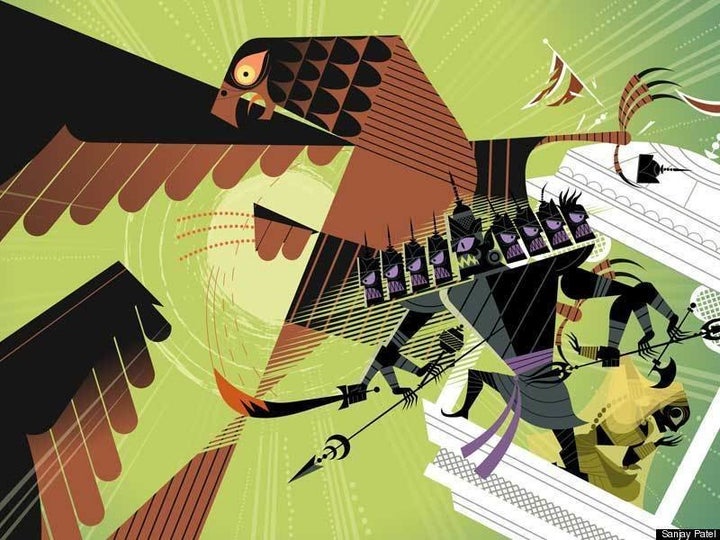
I'm certain that for most people, "Ramayana" (RHAH-mah-YAH-nah) is just an unpronounceable word. But for me, the Ramayana is part of my cultural identity, though until recently I wouldn't have been able to explain what it meant if someone asked. Growing up in San Bernardino, I was immersed in the rituals and mythology of Hinduism. My parents are from an area of India called Gujurat. They immigrated to the US, via the UK, in 1980 and have spent the last thirty years living in and running a motel off Route 66. This made for an interesting childhood, to say the least, made even more bizarre by my father's daily devotional practice, which involved a morning puja during which he bathed a collection of murtis (idols of the Hindu gods) and stuck marigold petals to their foreheads with a dot of red paste. The world of the Ramayana was ingrained in me in the same way, through the cultural nuances of living with Hindu parents. For instance, every time I sneezed, my mom or dad would say, "Sita Rama." I had no idea what the phrase meant. Just like I had no idea why we had a framed illustration of a giant monkey carrying a mountain. Or why my dad made me count mala beads while chanting Rama, Rama, Rama. As a kid, I accepted these practices and references, but didn't understand them, and was often frustrated by them. All I really wanted to do was watch cartoons.
Fast forward about twenty-five years. I started to become interested in the Hindu deities -- both as a part of my cultural heritage, but also from an artistic standpoint. After doodling them and developing a few solid sketches, one day I decided I was going to create my own book. I illustrated it and wrote it, and it actually got published as The Little Book of Hindu Deities. And believe it or not, people actually liked it. I ended up creating something that, hopefully, little kids growing up in between Indian and American cultures could relate to and feel proud of when they showed their friends. I was so inspired by the experience that I decided to make a second book. I tossed around a lot of ideas, but once I picked up on the Ramayana, all other potential book proposals hit the back burner. I was hooked on this epic Indian tale. As I started researching Hindu mythology for my first book, I began to scratch the surface of the Ramayana. But the story didn't really come alive for me until I picked up a book and read the entire saga.
Funny thing is, I love books, but I hate reading them.
Books put me to sleep. I can't even read a comic book without getting distracted by the cool artwork. As bad as I am about reading, I'm even worse with writing. This probably explains why my books don't have very many words.
I discovered a wonderful English-language fantasy adaptation of the Ramayana by the esteemed author Ashok K. Banker. His retelling weighed in at roughly three thousand pages, and it took me the better part of a year to read. As I read, the mythology sprang to life with full force, in all its wisdom, and I could feel my life being changed. For the first time, I began to see and understand the characters Rama and Sita as my parents did. I began to understand why it would be considered auspicious to speak their names, or why the monkey god Hanuman's devotion to Prince Rama -- epitomized by the extraordinary feat of moving a literal mountain of medicine -- would be worthy of worship. It all began to make sense as I discovered a story that is the bedrock of Hindu and Indian culture.
The Ramayana's characters and legends have been deified and worshipped throughout India and much of Southeast Asia for thousands of years. The enduring story is preformed and revered in Thailand as the "Reamker," as well as in Burma, Laos, and Malaysia. The Ramayana has crossed cultures and eras and shows no sign of dying, as its conflicts and themes are as relevant and constant as the human spirit.
The more I began to understand the Ramayana, the more inspired I felt to carry on the tradition of retelling the tale by creating an illustrated version. Since most people aren't inclined to sit through a thousand-page-long adaptation, I relied on graphic storytelling to capture peoples' attention and imagination and convey large chunks of the plot. With this same spirit in mind, I wrote a much shorter and surmised version of the mythology. So if you're familiar with the Ramayana, chances are some anecdotes and details may be missing or reimagined in the version I created. My aim isn't to butcher this great mythology but simply to share it with people in a casual and entertaining way. If I've done my job right, Ramayana: Divine Loophole serves as a vivid introduction to a much fuller version of the story. At the very least, it will help people understand why Hindus honor a blue warrior and a flying monkey holding a mountain -- and maybe help some Indian American kids out there find a 21st century bridge to the ancient stories their parent made them learn.
See illustrations from Ramayana: Divine Loophole below:
